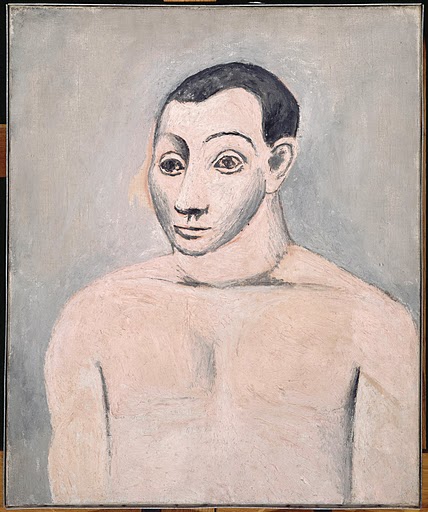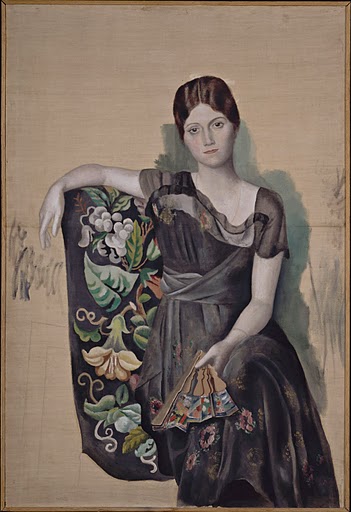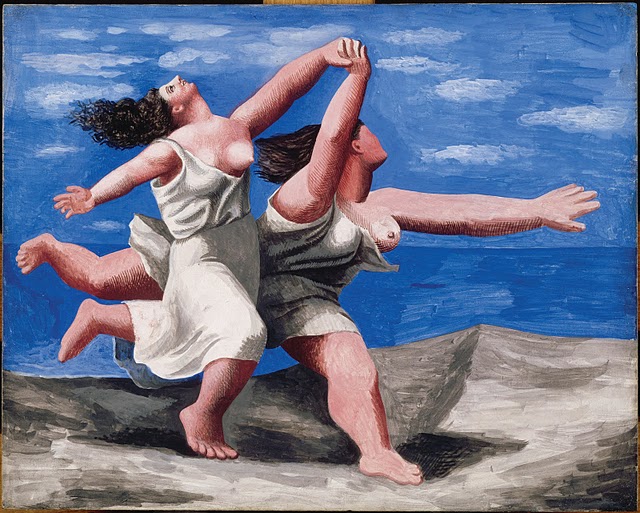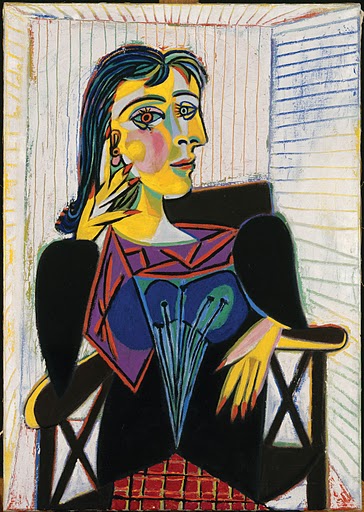Mounting an exhibition of works from the Musée Picasso was a no-fail option for the de Young. It is far from the first museum that has relied on Picasso to get a guaranteed blockbuster. According to The Art Newspaper, last year’s exhibition, “Picasso in the Metropolitan Museum of Art,” was the 8th most popular of all the shows held in 2010, attracting more than 700,000 visitors. “Picasso and the Masters,” which ran at the Grand Palais in Paris from October 2008 to February 2009, was also a tremendous success, bringing in 783,352 visitors (on average 7,270 a day). During the last days of the exhibition, when the museum kept its doors open 24 hours a day, the financially crisis-stricken Parisians didn’t mind waiting outside, in the cold, until 3 am to see the Modern painter’s tributes to the greats of the past (and pay 12 euros for that privilege).
Of course, Picasso’s fame didn’t fail to get recognized by the art market. In May 2010, somebody bought this painting for 106.5 million dollars (the de Young is showing a few similar ones – and better ones, too). Keeping in mind that Picasso’s auctioned works have also brought in amounts like 95.2 million and 104.2 million dollars, I couldn’t help but wonder how much the paintings in this exhibit would fetch if they hit the auction block. Even more exorbitant sums, I suppose, since pieces with museum provenance are very highly sought after by art (and concomitant prestige)-hungry billionaires.

Pablo Picasso Autoportrait (Self-Portrait) Oil on canvas. 1906 Musée National Picasso, Paris © 2011 Estate of Pablo Picasso/Artists Rights Society (ARS), New York.
That said, I personally know a bunch of people, who, at the sole mention of the name “Picasso,” would quip “Overrated!!” And those are not modern art n00bs who say things like “My kid could paint that.” For some, his work is misogynistic, but what could you expect from a man who grew up in late 19th-century Spain? Others think it fatally lacks refinement. Then, there are those who are just too uncomfortable with his disruption of the wholeness of the figure (“My picture is a sum of destructions,” he once said). But even for Picasso-skeptics, missing a show of his works is blasphemy – mostly because not many exhibits can assure as many “WTF?!” moments as his. The unconvinced might even start to think of Picasso much more favorably (I have one such former skeptic at home).
Even though Picasso’s art is truly ubiquitous (the master was very prolific, and there are creations of his in seemingly every museum and auction catalog), seeing a bunch of his works all at once still provides a visceral punch. I’ve been a longtime fan of early Picasso, of the absinthe-sickened elongated figures of his Blue Period and the inhuman stares on his “African” works, but I’ve never understood his other periods that well. My big discovery at the de Young was his Surrealist period of the ’20s and ’30s, and the biggest “WTF” moment was provided by the tiny painting of what looked like anthropomorhic flesh constructions merrily playing a ball game at the beach. Not many artists were as deft at violating the human form as the Spaniard.

Pablo Picasso Portrait d’Olga dans un fauteuil (Portrait of Olga in an Armchair) Oil on canvas. 1918 Musée National Picasso, Paris © 2011 Estate of Pablo Picasso/Artists Rights Society (ARS), New York.
The de Young (provocatively) did not include any wall text, which would have explained the meaning of the works, and instead let the viewers figure out the interpretations by themselves and come up with ingenious comments, e.g. “This looks like something out of Star Trek!” This exhibit’s chief narrative, I would say, is “Picasso and his women,” since almost every one of his styles had a muse associated with it. From the Cubist room, with its Star Trek-like sculptural head of Picasso’s first big crush, Fernande Olivier, we step into the space dominated by the classical-inspired portrait of his first wife, the bourgeois Russian lady Olga Khokhlova. That painting (pictured above) is one of the most conventionally realist of all the works on view. Don’t think that the Classical-period Picasso betrayed his taste for the grotesque, though: the other pieces in the room testify to the opposite, just look at the shovel-like limbs of the “Two women running on the beach” (pictured below). Some critics even go so far as to say that Picasso mocked the classical inspirations, which were fashionable in the interwar era.

Pablo Picasso Deux femmes courant sur la plage (La Course) Two Women Running on the Beach (The Race) Goache on plywood. 1922 Musée National Picasso, Paris © 2011 Estate of Pablo Picasso/Artists Rights Society (ARS), New York.
During his Surrealist years, Picasso had the young and pretty blonde lover, Marie-Thérèse Walter, who inspired him to make bright, sensual paintings (it was a picture of her that got sold for 106.5 million dollars). One work on view features her as a kind of pink pillow with boobs, another has her face divided into what looks like two halves of an exotic fruit. If you move onto the next room in the exhibit, you’ll see that their relationship didn’t last forever. Before long, the artist was painting Marie as a wailing crying monster with giant teeth. Her unhappiness (as you might have guessed) was in fact his fault: there was a time when the Andalusian womanizer had affairs with both Marie and the artist Dora Maar, while still being married to Olga. Dora Maar also had a fair share of ugly pictures devoted to her, as well as supremely lovely pictures – examples of both are included in the show. One of my favorites is the one where Dora looks at you with her huge pretty eyes like a Buddha, and her face is mostly shiny happy yellow. In the last room there is a touching late painting, where the very, very old Picasso clings to his second and last wife Jacqueline (whom he married when he was almost 80).

Pablo Picasso Portrait of Dora Maar, 1937 Oil on canvas Musée National Picasso, Paris Photo: Jean-Gilles Berizzi/Réunion des Musée Nationaux/Art Resource, New York © 2011 Estate of Pablo Picasso/Artists Rights Society (ARS), New York.
You can see these pieces and many more at the de Young museum until October 10th. The organizers strongly encourage you to buy tickets in advance, since the exhibition is proving to be quite popular. It also should be mentioned that the de Young’s sister museum, the Legion of Honor, is also displaying a few ceramic works by Picasso. They are on view at the Bowles Porcelain Gallery until December 11.
RELATED LINKS
Picasso: Masterpieces from the Musée National Picasso, Paris at the de Young
Let us know what you think! Follow us on Twitter and like us on Facebook to give us a shout. You can also stay on top of exciting events from around the world by downloading the eventseeker app for iPhone, Android or Windows.
